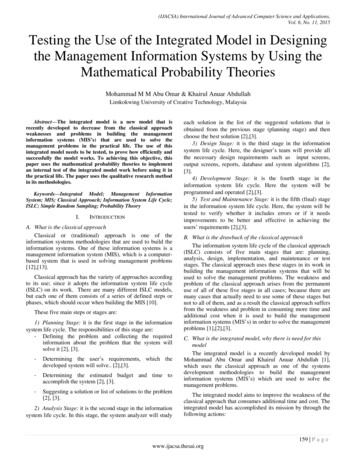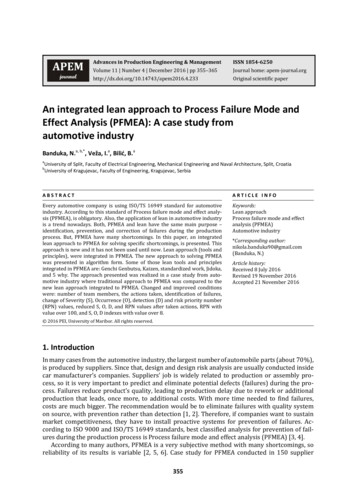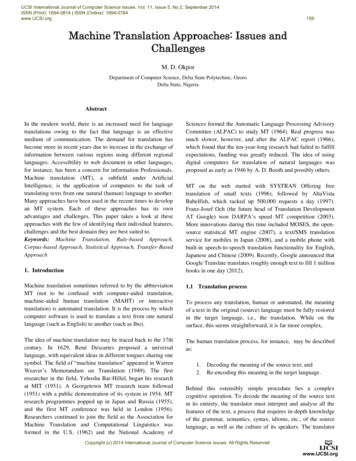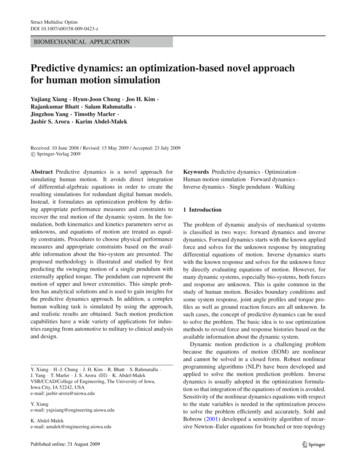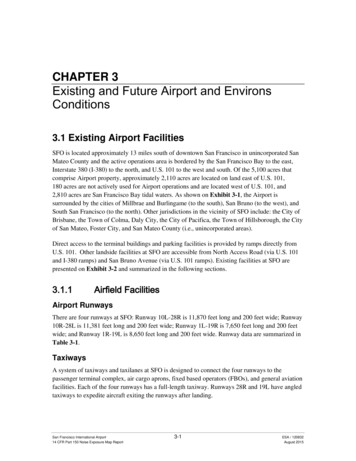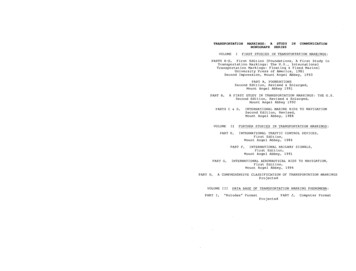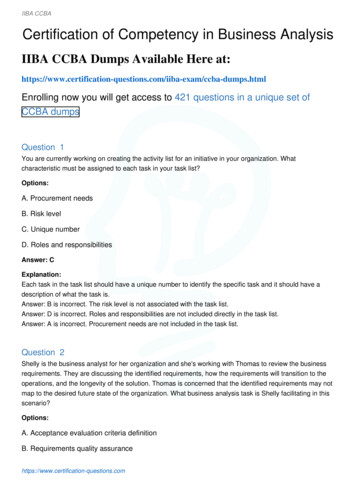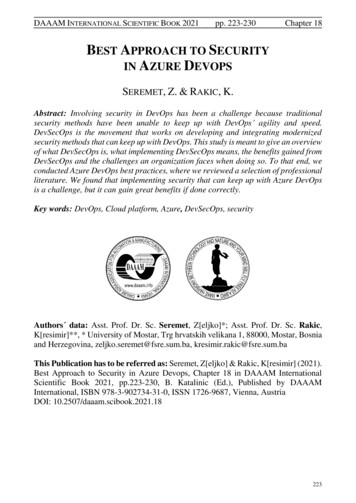
Transcription
DAAAM INTERNATIONAL SCIENTIFIC BOOK 2021pp. 223-230Chapter 18BEST APPROACH TO SECURITYIN AZURE DEVOPSSEREMET, Z. & RAKIC, K.Abstract: Involving security in DevOps has been a challenge because traditionalsecurity methods have been unable to keep up with DevOps’ agility and speed.DevSecOps is the movement that works on developing and integrating modernizedsecurity methods that can keep up with DevOps. This study is meant to give an overviewof what DevSecOps is, what implementing DevSecOps means, the benefits gained fromDevSecOps and the challenges an organization faces when doing so. To that end, weconducted Azure DevOps best practices, where we reviewed a selection of professionalliterature. We found that implementing security that can keep up with Azure DevOpsis a challenge, but it can gain great benefits if done correctly.Key words: DevOps, Cloud platform, Azure, DevSecOps, securityAuthors data: Asst. Prof. Dr. Sc. Seremet, Z[eljko]*; Asst. Prof. Dr. Sc. Rakic,K[resimir]**, * University of Mostar, Trg hrvatskih velikana 1, 88000, Mostar, Bosniaand Herzegovina, zeljko.seremet@fsre.sum.ba, kresimir.rakic@fsre.sum.baThis Publication has to be referred as: Seremet, Z[eljko] & Rakic, K[resimir] (2021).Best Approach to Security in Azure Devops, Chapter 18 in DAAAM InternationalScientific Book 2021, pp.223-230, B. Katalinic (Ed.), Published by DAAAMInternational, ISBN 978-3-902734-31-0, ISSN 1726-9687, Vienna, AustriaDOI: 10.2507/daaam.scibook.2021.18223
Seremet, Z. & Rakic, K.: Best Approach to Security in Azure Devops1. IntroductionDevOps (Fitzgerald et al., 2017) has solved several software engineeringproblems, including the friction and delay in the software delivery and problemresolution. Being a manifesto designed more than a decade ago, DevOps now needs aredesign in its software development, management, and delivery, approaches. Thisplanning can help solve the loopholes in the pipelines and cycles in DevOps. Thestarting principles of DevOps needed a quick response for user needs/bugs and lessfriction between teams—typically the development and operational teams. AlthoughDevOps approaches these problems quite fairly, what it misses is the important aspectof modern software: the maintenance of the software.A modern approach to software development requires the product have enoughsecurity, performance, efficiency, and a better UX to enable customers to perform theirtasks. Users should also be able to know how the application uses the data it receives.One of the main emphases put on today’s software is on security and data privacy.Security comes in all shapes and sizes. A solution must run on a desktop, a mobiledevice, a distributed environment on the cloud (Celar et al., 2011), and the smallest andlowest powered of the devices, the IoT (Internet of Things). Our software comes toe totoe with unwanted user interactions on the interface and attacks on the servers thatmight compromise not only the solution but also the data of other users.So, in the second chapter, we discuss the security of DevOps (DevSecOps). Thethird chapter will describe one of the more influential DevOps cloud platforms(Microsoft Azure DevOps), and the fourth chapter the security aspect with Azurepolicies. Finally, in the fifth chapter, Azure Security Best Practices are proposed, andin the sixth, a conclusion is given.2. DevSecOps processIntroduction of agile development methodology was a huge leap towards moreorganized and ideal development cycle. But where agile tends to solve thecommunication problems with developer and the client DevOps strives to also solvesimilar problem between developer and operations. Therefore, many view DevOps asthe logical continuation of agile method. This can also be noticed when looking intoDevOps culture since DevOps shares multiple similarities with agile development.DevOps culture got introduced because it was noticed that the developers and IToperators rarely worked together as a team toward the same goal, but they worked asseparate units. (Myrbakken et al., 2017)With everyone moving to the cloud, there’s been so much hype over DevOps andhow it can make processes faster, easier, and more efficient. As someone in securitythough, he feels fear that there is no emphasis on moving to the cloud securely. EnterDevSecOps. (Clarke et al., 2017)DevSecOps is about introducing security earlier in the software development lifecycle (SDLC) (Fig. 1). The goal is to develop more secure applications by makingeveryone involved in the SDLC responsible for security.224
DAAAM INTERNATIONAL SCIENTIFIC BOOK 2021pp. 223-230Chapter 18Having business, tech, and security work together to produce secure productsseems like a dream come true. Maybe too good to be true? Let’s investigate more andsee if DevSecOps can be the silver bullet we all need in building secure products.Fig. 1. DevSecOps Life CycleFirst, let’s talk about why we need DevSecOps. Years ago, software productsfollowed the waterfall methodology, a linear sequential approach for developing aproduct that concluded with a “big-bang” release. (Chatterjee, 2020)With the shift to cloud computing and dynamic provisioning of resources,developers have gained numerous benefits around speed, scale, and cost of applicationdevelopment. These benefits lend themselves so nicely to the adoption of the DevOpsmovement. DevOps strongly advocates for automation and monitoring at all steps ofthe SDLC.The goal is for shorter development cycles, increased deployment frequency andmore dependable releases, all aligned with business objectives. But stableinfrastructure and applications does not equal secure infrastructure and applications. Inthe waterfall lifecycle, security checks were put at the end before the product wasreleased. Security was seen as a roadblock, the last gate-check, on the way to aproduction release. Many things have changed regarding how applications aredeveloped, but not how security is viewed. (Ahmad Zeeshan, A., 2020)The most teams use the agile methodology for software development. In an agileenvironment, the focus is on rapid delivery. By using iterative planning and feedbackresults, teams can continuously align product deliverables to business needs. Theadaptability to changing requirements is great for delivering a meaningful product, butif you’re releasing a new version of your product every week, when do you test forsecurity vulnerabilities? Unfortunately, traditional security processes have not keptpace in agile/DevOps environments rendering security to become a major roadblock insoftware development where it is usually bypassed.If it’s not bypassed, the development team rarely has enough time to address allthe issues before the product goes live which means that an insecure application livessomewhere on the internet. The ironic part is that ignoring security to avoid the risk ofmissing a deadline puts more risk into the application. Security defects in the SDLCcan lead to serious vulnerabilities like a breach caused by bad code. Therefore, we needDevSecOps.In DevSecOps the two seemingly opposing goals, “speed of delivery” and “securecode”, are merged into one streamlined/automated process. The intent of DevSecOpsis to build on the mindset that “everyone is responsible for security”. It is about pushingsecurity left and automating core security tasks.225
Seremet, Z. & Rakic, K.: Best Approach to Security in Azure DevopsWe can push security to the left of the SDLC to ensure that application securitystarts as one codes. By shifting left, teams can quickly discover and analysevulnerabilities and then adapt their code to mitigate against those vulnerabilities.DevSecOps allows developers to focus on writing high quality and secure code,enabling teams to release titanium applications.The benefits are simple: security from the start minimizes the chance of vulnerabilities having automated security tools running in pipelines is that it lets security teammembers focus on the high-hanging fruit better collaboration and communication between dev and security teams improved operational efficiencies across security and the enterpriseHowever, there are challenges associated with DevSecOps. Even with securitybaked into a pipeline, there are still ways to circumvent security checkpoints. Let’s takean example where a vulnerability scanner is being used to block a build/deployment ifa certain vulnerability is found. As a developer, you know what that vulnerability isand you know your code has it, but you really need to do this release. So, you find away to hide pieces of the code that you know will fail a security scan, resulting in asuccessful build. Another common situation is when teams decide to break their buildif there’s a presence of one or more findings of a certain severity. For example, a teammay say that they do not want to break their build unless the finding is high or critical.While this certainly helps identify and address high priority issues immediately, theconsequence is that medium and low findings make it to production builds.Now that we’ve gone over the pros and cons of DevSecOps, how does oneimplement it? The traditional DevOps tools such as Jenkins and Git are a must have tobuild the foundation of your DevOps pipeline. There are many security tools in themarketplace ranging from open source to proprietary solutions. Many of these can beintegrated into your existing pipelines.Below is a popular list security tool: Checkmarx: A SAST (Static Application Security Testing) Tool that analyzes anapplication’s code for flaws which are indicative of security vulnerabilities. WhiteSource: An open-source vulnerability scanner, which runs automatically andcontinuously in the background, tracking the security, licensing, and quality ofopen-source components and matching them against WhiteSource’s comprehensivedatabase of open-source repositories. Zaproxy: The OWASP Zed Attack Proxy (ZAP) is an easy-to-use integratedpenetration testing tool for finding vulnerabilities in web applications.So, is DevSecOps the magical cure to all our problems? Maybe not all ourproblems, but for many it is irreplaceable, and this is one hype train that should beready to board and go to the end. (Chatterjee, 2020)226
DAAAM INTERNATIONAL SCIENTIFIC BOOK 2021pp. 223-230Chapter 183. DevOps cloud platformsApp creators have many DevOps tools to choose from, and the sheer number isenough to make anyone’s head spin. One of the better available DevOps tools,Microsoft Azure DevOps, will be described in more detail below.3.1 Microsoft Azure DevOpsMicrosoft Azure DevOps is the Microsoft’s take on DevOps solutions. This solution isthe evolved form of the former Visual Studio Team Services.Azure DevOps includes five different services: Azure Boards: This covers agile planning, work item tracking, and visualization,and reporting tools. Azure Repos: This offers a cloud-hosted private Git repository, with pull requests,advanced file management, and other benefits. Azure Pipelines: This is a language, platform, and cloud-agnostic CI/CD(Continuous Integration/Continuous Delivery) platform with support for containersor Kubernetes. Azure Test Plans: This service provides an integrated, all-in-one planned, andexploratory testing solution. Azure Artifacts: The artifacts in question provide developers with integratedpackage management, including support for Maven, npm, Python, and NuGetpackage feeds from either public or private sources.These services are extensible and flexible, and they can be used with differentplatforms and clouds so the user may choose not to use the default Azure cloud solutionwhen using these Azure tools. Azure Repos, Test Plans and Artifacts can be integratedwith Azure Pipeline’s CI/CD. Azure DevOps also offers a variety of extensions andsupport for user created extensions. There are extensions for example for Docker,Slack, GitHub, Sonar Qube and AWS tools. Many of these extensions are offered free,but some may require paid subscription. (Microsoft Corporation, 2020)Azure DevOps Services’ pricing model will mostly depend on how big of a teamis working with Azure Cloud. Even with the free version users gain access to AzureBoards, Azure Repos, Azure Artifacts, Azure Test Plans and Azure Pipelines. TheseCI/CD pipelines costs change how much traffic and how many multiple parallel jobscan be done at the same time. Azure Portal is also needed to host virtual machines whendeploying the apps. Costs for Azure Portal can be changed with different subscriptions.3.2. Workflow in AzureWorkflow with Azure is quite simple, but there are few things to be noted. First usercreates a branch inside Azure DevOps and then either clones the Azure repository ifthis is the first time working with project, or, if user already has repository set in thelocal environment, they can just pull the new branch and start working on it.227
Seremet, Z. & Rakic, K.: Best Approach to Security in Azure DevopsAfter the changes are made and user is ready to push the changes to repository, acommit is needed to be made that describes the changes. After the commit, the usercan push changes to Azure DevOps. Then from inside the Azure DevOps site, whenclicking on the “Repos” tab there is notification that states there are new changes in thebranch. It also proposes making a pull request out of it. (Priyadarsini et al., 2020)Pull requests are used by development team to review the changes to the code.The changes can be approved, rejected and other team members can comment onchanges and suggest alternative fixes for the code. Pull requests can be managed fromunder the “Repos” tab and selecting “Pull requests”. Here, users can create a new pullrequest for the branch they have been working on. If someone is set as a reviewer forcode changes made by others, they will see those requests here. When the right numberof reviewers have accepted the changes the pull request can be created. This will mergethe changed branch to a master branch. (Microsoft Corporation, 2020)Next is the continuous pipeline’s turn to start doing its part. This pipeline can bemodified to automatically start the deployment process when the master branch ischanged. This means that it builds the code and does the tests included in it. There isalso an artifact created after the build process. The artifact is then deployed to thevirtual environment by the deploy stage. After the pipeline has run its stages, thechanges can be seen in the deployment environment. (Microsoft Corporation, 2020)4. Security with Azure PoliciesAzure Policies are as important as the cloud platform itself and very relevant inDevOps. It is not just a security tool but to enforce organization structure andcompliance. It can be used to manage costs, ensure security best practices, and reducethe scope of the search when things go wrong and help in default and custom policies.In DevOps, Azure Policies are vital for the providing technical security and consistencyin enforcing industry and business standards then ultimately compliance.Some key points are shown as follows: They give us a way to manage costs by restricting specific resources. Because of the policy-enabled secure architecture, we can determine the scope,source, and solution of problems more quickly. Through policy-enabled configuration management, unexpected or even unwantedconfiguration changes can be prevented. (Microsoft Corporation, 2020)4.1 Custom Policy DefinitionsAzure policies are written in JSON (JS Object Notation) and can be deployed in theportal or the CLI.Policies have two modes: Indexed: This evaluates only resource types that support tags and locations. All: This evaluates resource groups, subscriptions, and all resource types.228
DAAAM INTERNATIONAL SCIENTIFIC BOOK 2021pp. 223-230Chapter 18However, the rules themselves follow a simple if-then structure, where if theconditions in the policy rule are met, the effect specified in the “then” block occurs.(Microsoft Corporation, 2020)4.2 Network Security GroupsNetwork Security Groups (NSGs) are a collection of networking rules that dictate theflow of traffic to and from resources in Azure. When NSGs are created, there arenumerous customization that can be made and some of them are: Name Priority: Ranges from 100–4096 Source or Destination: A single IP or CIDR can be considered Protocol: All the networking protocols Direction: Tells us whether the rule applies to the traffic into the network Port Range: 3000–30010 Allow or Deny Action Allow (Choudary, 2017)5. Azure Security Best PracticesAzure DevOps with a comprehensive list of best practices while consideringsecurity include: Treat Identity as security perimeter (like for verification and access. Identitymanagement must be centralized). It is not necessary to have two references to an identity. Enable single sign-on so users can use the same credentials to resources so they caneasily control things. There must be strong network controls to connect VM across networks and controlthe traffic for the VMs. Segment subnets must be controlled logically while resources belong to thestrongest security zone. More network space needs to be allocated than is required when setting up theinfrastructure. Don’t assign NSG rules with broad ranges and be particular with who has access towhat in the system. Finally, it is necessary to explore the goodies of the Azure security centre.(Microsoft Corporation, 2021)6. ConclusionThis paper presents the research we did on DevSecOps to find out howDevSecOps can be defined, what doing DevSecOps means for an organization inregard to what principles and practices they should adhere to, what challenges theywould face attempting to adopt DevSecOps, the benefits if it’s done successfully andhow it has evolved from the need to implement security in DevOps to what could seemlike a movement on its own.229
Seremet, Z. & Rakic, K.: Best Approach to Security in Azure DevopsWe have identified several challenges and benefits for implementing the securityof one of the major cloud platforms, Microsoft Azure DevOps. The challenges weidentified should not be seen as deterrents to implementing DevSecOps, but a symptomof its youth. As DevSecOps matures, better methods, practices, tools etc. can probablyovercome them. The benefits we identified indicates it is maturing, by for exampleresulting in less unplanned work and a decrease in manual labour.As future work, it would be interesting to conduct surveys on organizations topossibly expand this study’s coverage on DevSecOps. It is also of interest to investigatethis study’s suggested practices: observing practices effects on the surroundingenvironments (development, operations, business, customers) confirm the proposedbest practices. A possibility would then be to investigate and propose possiblearchitectures or frameworks for implementing DevSecOps, for example look atcontinuous software engineering while using a microservices architecture.7. ReferencesAhmad Zeeshan, A. (2020). DevSecOps for .NET Core, ISBN: 978-1-4842-5850-7,Apress, Berkeley, CACelar, S.; Seremet, Z. & Turic, M. (2011). Cloud computing: definition, characteristics,services and models, Annals of DAAAM for 2011 & Proceedings of the 22ndInternational DAAAM Symposium / Katalinic, Branko - Vienna: DAAAMInternational Vienna, 2011, 0001-0002Choudary, A. (2017). Secure Your Applications Using Azure Virtual NetworkAvailable from: ecuring-yourapplications-using-vpc-744eba3aa5b1 Accessed: 2021-10-19Clarke, P. M., O’Connor, R.V., Elger, P. (2017). Continuous software engineering–amicroservices architecture perspective. J. Softw. Evol. Proc. 2017, e1866devops/user-guide/services?view azure-devops Accessed: 2020-05-19.Fitzgerald, B. & Stol, K. J. (2017). Continuous software engineering: a roadmap andagenda, J. Syst. Softw. 123, 176–189K. Priyadarsini, K.; Fantin Irudaya Raj, E.; Yasmine Begum, A. &Shanmugasundaram, V. (2020). Comparing DevOps procedures from the context of asystems engineer, Materials Today: Proceedings, Volume 47, Part 19Microsoft Corporation. Azure Identity Management and access control security gement-best-practices Accessed: 202111-19Microsoft Corporation: What features and services do I get with Azure DevOps?Available from: https://docs.microsoft.com/en-us/azure/Myrbakken H. & Colomo-Palacios R. (2017). DevSecOps: A Multivocal LiteratureReview. In: Mas A., Mesquida A., O'Connor R., Rout T., Dorling A. (eds) SoftwareProcess Improvement and Capability Determination. SPICE 2017. Communications inComputer and Information Science, vol 770. Springer, Cham.R. Chatterjee (2021). Introduction to IT Security. In: Red Hat and IT Security. Apress,Berkeley, CA.230
DAAAM INTERNATIONAL SCIENTIFIC BOOK 2021 pp. 223-230 Chapter 18 BEST APPROACH TO SECURITY IN AZURE DEVOPS SEREMET, Z. & RAKIC, K. Abstract: Involving security in DevOps has been a challenge because traditional security methods have been unable to keep up with DevOps' agility and speed. DevSecOps is the movement that works on developing and integrating modernized



